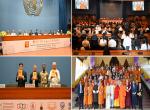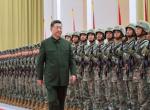The shift to clean energy has significantly increased the demand for critical materials. Technologies such as solar panels, wind turbines, and electric vehicle batteries require far more minerals than traditional fossil fuel-based systems, making the clean energy sector the primary driver behind the rising demand for these essential resources. From 2017 to 2022, the energy sector contributed to a 300% increase in lithium demand, a 70% rise in cobalt demand, and a 40% surge in nickel demand.[1] By 2022, clean energy accounted for 56% of global lithium demand, 40% of cobalt demand, and 16% of nickel demand. The World Bank forecasts that by 2050, production of graphite, lithium, and cobalt will need to rise by over 450% from 2018 levels to meet growing energy storage demands.[2]
Supply Chain Vulnerability
Critical minerals are highly susceptible to supply disruptions due to the concentrated nature of their deposits and production. As of 2022, just 15 countries controlled over 55% of the world’s identified critical minerals and were responsible for more than 70% of global production.[3] These countries are Australia, Brazil, Chile, China, the Democratic Republic of Congo, Gabon, Indonesia, Madagascar, Mozambique, New Caledonia, Peru, the Philippines, Russia, South Africa, and the US.
The refining and processing of critical minerals are even more concentrated, with China commanding a dominant share of the market. For example, the country processes 42% of cadmium, 65% of cobalt, 42% of copper, 58% of lithium, 35% of nickel, 87% of rare earth elements (REEs), and 68% of silicon, among others.[4] This control has become a key element of China’s geopolitical strategy. A notable example occurred in 2010, when China imposed an REE export ban on Japan following a diplomatic dispute.[5] More recently, critical minerals have become central to the US-China tech rivalry. In 2022, the US, along with Japan and the Netherlands, restricted China’s access to semiconductor technology. In retaliation, China imposed export controls on gallium, germanium, and graphite and restricted REE extraction technology.[6]
With the US-China technology rivalry showing no signs of abating, China is likely to continue leveraging critical minerals as a strategic tool against the US and its allies. This poses a significant challenge for India as well. India has limited domestic production of critical minerals and relies entirely on imports for lithium, cobalt, nickel, vanadium, niobium, germanium, rhenium, beryllium, tantalum, and strontium.[7] Additionally, India imports 80% of its zirconium, 60% of its graphite, and 50% of its manganese. China is a dominant supplier of many of these minerals to India. For example, between 2019 and 2024, China accounted for 85.6% of India’s bismuth imports, 82% of its lithium, 76% of its silicon, 50.5% of its titanium, 48.8% of its tellurium, and 42.4% of its graphite.[8] This heavy reliance on imports places India in a precarious position, making it vulnerable to supply chain disruptions, price fluctuations, and geopolitical tensions.
India's Growing Focus on Critical Minerals
India’s demand for critical minerals is set to grow as the country advances its clean energy initiatives and expands electronics manufacturing. To address this, India has prioritized securing a stable supply of these minerals. As part of this strategy, the national budget for 2024-2025 exempts Basic Customs Duty (BCD) on 25 critical minerals and reduces duties on two others. The 2025-2026 budget further broadens these exemptions, adding 12 more critical minerals to the list. These measures could lower the costs of critical minerals in India, enhance their availability, and encourage the development of domestic processing facilities.
Then on January 9, 2025, India launched the National Critical Mineral Mission (NCMM), marking a major advancement in securing the nation's mineral future. The mission is designed to accelerate both domestic mineral exploration and the acquisition of overseas assets. It also aims to streamline regulatory approvals for mining projects and foster initiatives focused on recycling critical materials. To achieve these goals, the NCMM has allocated an initial investment of Rs. 16,000 crore (approximately USD 1.9 billion) over the next seven years.[9] In addition, central public sector enterprises are set to contribute around Rs. 18,000 crore (roughly USD 2 billion), bringing the total funding to Rs. 34,300 crore (about USD 4 billion).
Over the past three years, the Geological Survey of India (GSI) has successfully completed 368 exploration projects, with 195 currently underway. Additionally, it plans to launch 227 more projects this year. The NCMM aims to accelerate this momentum, setting an ambitious target of completing 1,200 exploration projects by 2030-2031. To support this initiative, the NCMM has allocated Rs. 3,000 crore (approximately USD 346 million) to the National Mineral Exploration Trust (NMET), while Rs. 4,000 crore (about USD 462 million) is designated for the GSI. These investments are poised to strengthen exploration efforts, generating vital data on mineral reserves that will attract greater investor interest and foster higher participation in mineral auctions.
India has also been accelerating its efforts to acquire overseas mining assets. For example, on January 15, 2024, it signed an agreement with Argentina to explore and develop five lithium brine blocks spanning approximately 15,703 hectares in the country’s Catamarca province.[10] The project is estimated to cost Rs. 200 crores (around USD 24 million). The NCMM aims to build on this momentum by acquiring 50 critical mineral mines worldwide in the coming years. To support this initiative, it allocates Rs. 5,600 crore (around USD 6.5 billion) to the National Mineral Exploration Trust (NMET) for risk coverage. Additionally, it plans to forge strategic partnerships with resource-rich countries to secure long-term mineral supply agreements.
Lastly, the NCMM has introduced a Rs. 1,500 crore (approximately USD 1.7 billion) incentive scheme aimed at advancing mineral recycling, with an ambitious target of recovering 400 kilotonnes (kt) of recycled material. In addition, it plans to establish four dedicated mineral processing parks, which will act as central hubs for the processing and recycling of critical minerals. A key component of this initiative is the formalization and integration of India’s large informal recycling sector, which, despite its significant contribution, often lacks standardized processes. By streamlining this sector, the NCMM seeks to increase recycling rates, create employment opportunities, and ensure a more sustainable and reliable supply of critical minerals for the country's growing industrial needs.
Conclusion
India’s growing demand for critical minerals, fueled by its ambitious clean energy goals and the rapid expansion of its industrial sectors, underscores the urgent need for a stable supply chain. To address this, India has implemented strategic initiatives like the National Critical Minerals Mission, backed by substantial budget allocations aimed at enhancing mineral exploration, acquisition, and recycling. These measures are designed to ensure a more secure and self-reliant mineral supply. By strengthening domestic production and forging international partnerships, India is not only securing its economic future but also positioning itself as a key player in the global mineral landscape. In doing so, the country is laying the groundwork for long-term resilience, reducing vulnerabilities, and fostering sustainable growth in critical industries such as clean energy and manufacturing.
Endnotes
[1] International Energy Agency (IEA). 2023. “Critical Minerals Market Review 2023.” Vienna.
https://iea.blob.core.windows.net/assets/c7716240-ab4f-4f5d-b138-291e76c6a7c7/CriticalMineralsMarketReview2023.pdf
[2] Hund, Kirsten et al. 2020. “Minerals for Climate Action: The Mineral Intensity of the Clean Energy Transition.” Climate Smart Mining Initiative. The World Bank Group. Washington, D.C.
https://pubdocs.worldbank.org/en/961711588875536384/Minerals-for-Climate-Action-The-Mineral-Intensity-of-the-Clean-Energy-Transition.pdf
[3] Council on Energy, Environment and Water (CEEW), International Energy Agency (IEA), Institute of Transportation Studies UC Davis and World Resources Institute India (WRII). 2023. “Addressing Vulnerabilities in the Supply Chain of Critical Minerals.” Report. April.
https://www.ceew.in/sites/default/files/addressing-critical-minerals-supply-chain-vulnerabilities-india.pdf
[4] Venditti, Bruno and Pernia Jamshed. “Visualizing China’s Dominance in Clean Energy Metals.” Visual Capitalist. January 23, 2022.
https://www.visualcapitalist.com/chinas-dominance-in-clean-energy-metals/
[5] Bradsher, Keith. “Amid Tension, China Blocks Vital Exports to Japan.” New York Times. September 22, 2010. https://www.nytimes.com/2010/09/23/business/global/23rare.html
[6] “China bans export of rare earth processing technology, citing national security.” The Straits Times. December 22, 2023.
https://www.straitstimes.com/asia/east-asia/china-bans-export-of-rare-earth-processing-technology-citing-national-security
[7] Ministry of Mines. 2023. “Critical Minerals for India.” Report of the Committee on Identification of Critical Minerals. June.
https://mines.gov.in/admin/storage/app/uploads/649d4212cceb01688027666.pdf
[8] Shetty, Rakshith. 2024. “Assessing the Nature of India's Critical Minerals Vulnerabilities vis-à-vis China.” Takshashila Discussion Document 2024-24. Version 1.0. Takshashila Institution. December.
https://takshashila.org.in/research/india-critical-mineral-vulnerabilities-vis-a-vis-china
[9] Ministry of Mines. “Cabinet approves ‘National critical Mineral Mission’ to build a resilient value chain for critical mineral resources vital to green technologies, with an outlay of Rs. 34,300 crore over seven years.” Press Release. January 29, 2025.
https://pib.gov.in/PressReleaseIframePage.aspx?PRID=2097309
[10] Ministry of Mines. “India signs agreement for lithium exploration & mining project in Argentina.” Press Release. January 15, 2024.
https://pib.gov.in/PressReleaseIframePage.aspx?PRID=1996380
(The paper is the author’s individual scholastic articulation. The author certifies that the article/paper is original in content, unpublished and it has not been submitted for publication/web upload elsewhere, and that the facts and figures quoted are duly referenced, as needed, and are believed to be correct). (The paper does not necessarily represent the organisational stance... More >>
Image Source: https://image.chitra.live/api/v1/wps/d639a24/aab8b335-856d-4bfb-a036-f09a0ec2f819/36/shutterstock-2261229835-1074x654.jpg











Post new comment